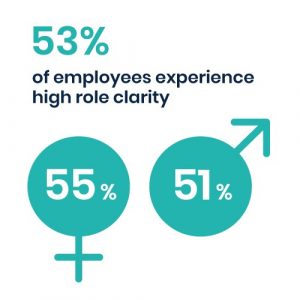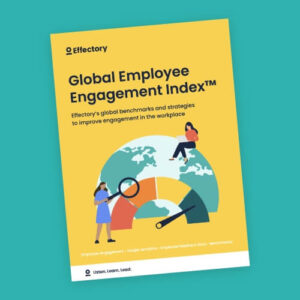In our research at Effectory International, we find that some countries and organisations score lower on the theme of role clarity than others. But how much does role clarity influence employee satisfaction? Can low role clarity be of benefit to employees?
How lower employee role clarity can be a good thing

Using data from our global employee survey (the Global Employee Engagement Index™), and a case study, we explore within this article the influence of role clarity. From our research, we illustrate how low employee role clarity is not necessarily a bad thing.
HR Analytics: Role Clarity infographic & fact sheet
Get data-driven insights about role clarity in the workplace by downloading this infographic and fact sheet.
DownloadGlobal vs Organisational
One of the organisations that Effectory International has recently partnered with is a large multinational technological organisation, with an emphasis on research and development.This organisation employs people on three different continents: Asia, Europe, and North America. We took a closer look at role clarity and role ambiguity in the organisation, and found that the pattern of scores within the organisation varies among regions, and also differs from the global average. When compared to the global average, a smaller percentage of employees within the multinational organisation experienced full role clarity, and a larger percentage experience role ambiguity. In addition to this, the added percentage of employees that experienced a lack of role clarity in priority setting or work method was higher than the global average.
What we found particularly interesting at this organisation was that the percentage of employees experiencing role ambiguity did not differ among Asia, Europe and North America. When we compare this to our global employee survey, we see a stark contrast as the global survey shows there to be clear trends and differences between continents. In our global survey, Asia had the highest percentage of role ambiguity, followed by Europe and then North America. The fact that the percentage of role ambiguity remained constant among the working regions of the organisation, suggests that their organisational culture may be a stronger predictor of the degree of role clarity experienced, than regional or country culture is.
Low role clarity
One of the most interesting trends that we uncovered in partnering with the multinational organisation was that in certain scenarios, employees needed to work in an environment with lower role clarity. Employees confirmed that this works out well for them, which could explain why this organisation’s overall score for role clarity was lower than the global survey average. By taking a deeper look at which themes the organisation scores highly on, we can begin to understand how lower scores for role clarity are not necessarily a bad thing for the organisation.
Global Employee Engagement Index™
Discover the Global Employee Engagement Index™ 2025 for key insights on driving employee engagement, improving performance, and enhancing team dynamics.
DownloadHigh-scoring themes
The multinational scored higher than the global average on many themes. The largest differences between the organisation’s scores and those of the global employee survey were for retention factor and loyalty, where the organisation’s employees scored 1.7 and 1.3 points above the global average respectively (noting an absolute difference). Retention factor and loyalty are two of the themes that form the basis of an organisation. In order for the organisation to function well in the long run, it needs employees who are on board and who can be invested in to build up the organisation. If the base of an organisation is solid, then employees who are willing or engaged will emerge. In this particular instance, the organisation scored highly on the theme of engagement.
Employee engagement is defined by Effectory International as an employee who gains energy from the work and is willing to put forth an effort to go the extra mile for the organisation. At this organisation, employees responded positively to the statements, “I enjoy my work”, and “My work is meaningful”, showing that they gain energy from their work. In addition, we found that they were much more willing to go the extra mile for the organisation than the global average1.
Employee empowerment
How could this organisation score highly on engagement, but not on role clarity? The answer could lie in the balance between leadership and freedom. Part of a manager’s role is to make sure that their employees know what their tasks and priorities are (micro-management). On the other hand there are also other important tasks for good management. Employees that are highly engaged thrive in an environment with a specific kind of leadership – one that is less focused on micro-management and more on freedom and empowerment for the employees.
The employee survey illustrated that employees at this organisation felt empowered, and we can see this from their positive responses to statements about recognising opportunities and making efforts to improve themselves in their job2.
The influence of Role Clarity
By using our correlation analyses we were able to further understand the influence of role clarity in this organisation3. We found that role clarity was one of lowest correlated themes to overall employee satisfaction, along with leadership. These results are slightly different from what we see in the global employee survey. On average, global role clarity is correlated higher4 with overall satisfaction, and leadership is correlated much higher5. We delved a bit deeper into these differences, and found that the largest discrepancy between the technological organisation and the global survey average was for Europe. In the global survey for Europe, role clarity and leadership were much more highly related to overall satisfaction than they were for the technical organisation’s employees in Europe.
In contrast, the theme that was highly related to overall satisfaction was work atmosphere. This result differed from the global survey in that on average, motivation is usually the theme with the highest correlation with overall satisfaction globally, and not work atmosphere. For the technological organisation, engagement had a higher correlation with overall satisfaction than role clarity did, as well as the themes of loyalty, employee commitment, and retention factor. This low correlation of role clarity with overall satisfaction reveals that role clarity does not necessarily play a leading role in the employees’ experience of a successful functioning organisational.
1 For the question,“I am willing to go the extra mile to contribute to the success of the organisation”, the global score was 7.6 while the score for the organisation surveyed was 8.4.
2 For the question,“I am willing to go the extra mile to contribute to the success of the organisation”, the global score was 7.6 while the score for the organisation surveyed was 8.4.
3 The correlation examines how strongly related each of the 17 organisational themes are to overall employee satisfaction.
4 Approximately 5 percentage points
5 Approximately 12 percentage points
Book a free demo. See our solutions in action.
Effectory is Europe's Leading provider of Employee Listening Solutions. Schedule a product demo and discover how to enhance your employees' engagement.
Demo request

